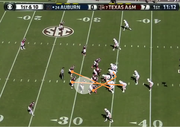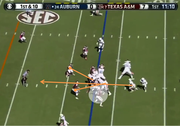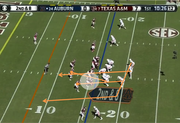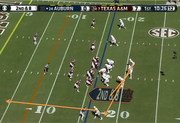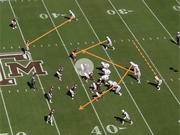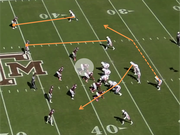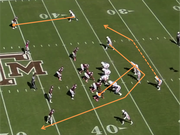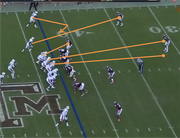FAYETTEVILLE — It’s Auburn Week, and the rivalry that Hog fans are getting excited about (in football; Auburn isn’t competitive in any other sport) will heat up starting on Saturday.
The fuel for the fire has already been poured on and will no doubt continue to be poured on in the future. Bret Bielema expressed his concern with Gus Malzahn’s hurry-up offense limiting substitutions, and Malzahn fired back. Just before the start of the season, former Razorback assistant (and current Tiger assistant) Tim Horton wished tight end Austin Tate a speedy recovery for an injury that Bielema had not yet released to the public. Now this week, Bielema claimed that Auburn has been doctoring game film sent to the Razorbacks, and that the SEC office has been notified. Folks around the Auburn program fired back, noting that Bielema making this news public is actually a minor violation.
Auburn Quick Facts
Head Coach: Gus Malzahn (7-1, 1st season)
2012 Record: 3-9 (0-8 SEC)
2013 Record: 7-1 (3-1 SEC)
Offense: Spread / Two-back read offense
Defense: 4-2-5
Total Offense: 13th NCAA
Rush Offense: 5th NCAA
Pass Offense: 97th NCAA
Total Defense: 75th NCAA
Rush Defense: 33rd NCAA
Pass Defense: 104th NCAA
And then on Tuesday, al.com Kevin Scarbinsky opened fire on Bielema in a fantastically flawed, Halloween-themed hit piece on the Arkansas coach. Scarbinsky, who once traveled through Arkansas and now considers himself an expert on the subject (as evidenced by his claim that Arkansans would overwhelmingly prefer Malzahn to Bielema as Arkansas’ coach), claims that Malzahn is actually running the “normal American football” used sarcastically that Bielema talked about in Birmingham, completely ignoring (or completely ignorant of) the fact that there’s a significant difference between the offense Malzahn runs and the speed at which he runs it, and Bielema was referring to the latter with his “normal American football” comment. Bielema hasn’t expressed any kind of disdain towards the spread offense.
All ignorance and ranting aside, the state’s long-lost son Gus Malzahn returns to Fayetteville on Saturday, still seeking his first win against the Razorbacks in the state since leaving in 2006.
THE HISTORY
Unlike Bret Bielema, whose coaching pedigree consists of legends Hayden Fry, Kirk Ferentz, Bill Snyder, and Barry Alvarez, Gus Malzahn’s pedigree consists of Houston Nutt, Todd Graham, and Gene Chizik. Not exactly legendary. Malzahn developed much of his offense on his own, and his system has evolved with time.
In the Arkansas high school ranks, Malzahn’s offense was pass-heavy. His introduction of the hurry-up spread offense changed the culture of Arkansas high school football (probably for the worse). He read a classic work of football philosophy called The Delaware Wing-T around the time he became head coach of tiny Hughes High School. The Wing-T offense was famous for its use of misdirection and is the foundation for most spread-running offenses. Malzahn used the Wing-T as the vessel for his real philosophy: the hurry-up, no-huddle. He used a lot of “Wing-T from shotgun” ideas at Shiloh Christian and even wrote a book on his “HUNH” system. In December 2005, with pressure mounting on Houston Nutt to hire an offensive coordinator, Nutt hired Malzahn to quell pressure and land Malzahn’s five-star quarterback Mitch Mustain.
The 2006 season is another story for another day, but Malzahn didn’t get much of his offense installed. He fled to Tulsa after the season and the Springdale Five experiment was over. As I wrote in my bye week article, the HUNH is as good a “quick fix” as you’ll find, and at Tulsa success came quickly. Malzahn joined forces with Rich Rodriguez’s former offensive line coach Herb Hand, and thus the slow evolution to a more run-heavy offense began. The 2008 Tulsa team was dominant through the air (302 yards per game) and on the ground (268 yards per game), leading the nation in total offense and claiming the Conference-USA title, although the Golden Hurricane was stopped short of a BCS bowl thanks to a 30-23 loss to the Razorbacks. Malzahn had a go-round at Auburn (2009-2011) and then became the head coach at Arkansas State for a year while Tiger fans watched Chizik collapse. Admitting he was the genius behind all their success was not hard, and Malzahn was announced as Auburn’s coach just hours after Bielema was hired by the Razorbacks.
THE FILM
Scarbinsky goes as far to call Auburn’s offense a “smash-mouth” which leads the reader to assume that he thinks all offenses that run the football are smash-mouths, which is decidedly untrue. Auburn’s offense is what can be described as a “modern spread.” It does use some classic football ideas, namely misdirection concepts from the Wing-T, but Auburn fans that claim that their offense is “power football out of shotgun” have deluded themselves into thinking so.
As previously stated, Malzahn’s offense has evolved but his hurry-up, no-huddle philosophy has remained consistent. Auburn has a very simple playbook and execution of a few ideas is stressed. To make play calls in a hurry-up offense simpler, Auburn makes extensive use of “series.” A series consists of a base play and a number of “complements,” which are similar plays or added-on concepts designed to take advantage of the defense’s adjustments to the base play.
A base play for Auburn will be the read option. Arkansas has seen a nearly-identical read option this season, from Terrance Broadway at Louisiana-Lafayette, and the Razorbacks passed the test, holding Broadway to -1 yards rushing and containing the read option play to under 3 yards per carry.
Auburn, however, will mix it up a little bit more. Here, the Tigers are reading the Aggies’ outside linebacker rather than a defensive end. As you can see, the linebacker committed to the outside, so Marshall hands the ball off to Tre Mason. There are three key blocks on the play, one by the center on the right outside linebacker, one by the pulling right guard against the defensive end (that’s called a trap block) and one by Auburn’s excellent fullback Jay Prosch on the middle linebacker. With the third and final linebacker optioned off, the play is almost guaranteed to be a big gainer up the middle. On this play, Auburn faced five defenders to one side (two defensive linemen and three linebackers) and successfully blocked four of them and optioned off the fifth. Auburn will look for “numbers game” matchups like that one to run the read option.
The “inverted veer” is a play that caused nightmares for the Razorbacks in Auburn’s only win against the Hogs since 2007: the 2010 game in Auburn when Cam Newton torched the Razorback defense. It’s the same thing as a read option, except that the quarterback takes the inside run and the back takes the outside run. A number of defenders can be read, but I’ve shown the defensive end read.
If you’ll recall all the way back to the Louisiana-Lafayette Preview (it’s been awhile), it was noted that one way to stop the read option was a “scrape exchange” in which the unblocked “read” defensive end crashes on the inside run while the linebacker crashes on the outside run. To counter this, read option teams have begun putting a fullback or H-back in the backfield to block the scraping linebacker. A diagram of the Ragin Cajuns attempting this against Florida was shown, but the ULL H-back wasn’t quick enough to stop scraping Gator linebacker Jon Bostic from blowing the play up. The conclusion was that ULL didn’t have the blockers necessary to stop the scrape. Enter Prosch, the Auburn fullback, who is a perfectly capable scrape blocker. When the Razorback defensive ends crash on the inside run, the Tigers will use Prosch to kick out the scraping linebacker and create a hole for the outside run.
Now, on the inverted veer play diagrammed, Auburn didn’t actually run the inverted veer. As with most of their passing plays, they faked it in play action. Here’s the actual play that they ran.
It’s a play action of the inverted veer, which would be called simply a sweep if Marshall were to hand it off with no option. There are only three options: throw the fade to Sammy Coates (bottom of the frame), dump it off to sweeping back Tre Mason, or scramble. Marshall chose option three and, thanks to a missed tackle, was rewarded with a touchdown.
Okay, let’s talk some series football. In this diagram, the dashed line is pre-snap motion. Auburn has a few options as far as playcalling goes for this one. The first is the classic read option with the read on the defensive end.
Eventually, the Aggie defense will want to stop the read option, so they’ll tell that outside linebacker to crash on the play when he sees it. As soon as he does, the Tigers can call a bubble screen to the motion back. If they want to get real fancy (and they often do), then they can package the read option with the bubble screen, giving Marshall a double-read option consisting of give/throw the bubble/run, in that order.
If the A&M defense begins to over-pursue the read and bubble, then enter the final option: reverse. Many of these slight variations that change the entire play are made after the offense has lined up and is looking over at the sideline.
Here’s a final look at the Auburn passing game. Coates is a receiver to watch. He’s a nasty mix of speed and physicality. They go to him here on a screen pass (called a tunnel screen). The timing of the play must be perfect, as the ball must be released before the linemen become ineligible downfield. The play works to perfection, and it’s a touchdown against the porous Aggie defense.
Stopping Auburn’s offense
So, how does one stop this extremely diverse spread offense, capable of mixing power run concepts, options, screens, play action, and deep passes? The short answer is that it is not easy, but it isn’t impossible. Arkansas lacks the personnel to stop Auburn consistently, but with a bye week to prepare it will be interesting to see what Chris Ash can come up with.
The zone blitz is almost always the first response to a new innovation in the spread offense world. The defense was popularized in college in 1990 by Texas A&M defensive coordinator Bob Davie. Davie was attempting to stop Houston’s famous Run-N-Shoot offense, and decided that he could throw off the Cougars’ reads by disguising pressure and allowing his defense to stay in a zone while they blitzed. Conceptually, Auburn’s offense also includes a lot of reads (although there are more running reads while Houston had passing reads) so a zone blitz could theoretically work if it was timed against a read play. Here, a fire zone blitz, the most popular form of zone blitz, is diagrammed.
In the diagram, the middle and strong linebackers crash and the weak defensive end drops back into coverage. If Auburn did not recognize this blitz (one of the benefits of the zone blitz is that it is easy to disguise) and called a read option against it, then the strong “read” defensive end would crash on the running back, forcing Marshall to keep the football. The strong linebacker blitz basically serves as a scrape, but scrape-blocker Prosch would have a problem: two linebackers are coming and he can only block one. Unless an offensive lineman makes a heroic block, this play will lose yards.
Of course, Arkansas’ problem remains personnel, not X’s and O’s. Auburn can call a variety of wrinkles and complements to the read option to circumvent a zone blitz, and if the Tigers throw, can Arkansas cover with a six-back Cover 3? The way the Razorback pass defense has looked in recent weeks, the Hogs may not can cover with ten back.
An option decidedly off the table for the current roster but decidedly on the table for Alabama and much of the NFL is the force gap exchange. It must be run from a 3-4 (Arkansas barely has the linebackers for a 4-3, much less a 3-4) or some other kind of two-gap defense (discussed below) and requires a fast-reacting safety and strong linebacker, and pass defenders who can hold their own in man coverage. Arkansas has none of these, but Alabama does. For Alabama, a “force call” is when the strong safety (now Landon Collins since Vinnie Sunseri tore his ACL against the Hogs) crashes on the read option. The defensive end crashes on the inside run, and the strong linebacker has the “squeeze,” meaning that he takes the block of the scrape blocker and attempts to force the quarterback out wide, giving the safety ample time to come in and make the tackle. Due to the quick reactions, the play requires that all pass defenders be able to hang on in man coverage with a single safety up top for help in case of a fake. Auburn will use wheel routes to backs coming out of the backfield in an attempt to beat this man coverage.
An option for the Hogs in the 4-3 defense is to use the strong safety against the run by bringing him into the box when Auburn uses two-back sets, and dropping him out of the box in one-back sets. In one-back sets, the Hogs can use a typical scrape exchange and in two-back sets, the strong safety will have to come down to cover the twin receiver or tight end. Alan Turner actually leads the team in tackles, so working against the run is not new to him (of course, it’s preferable that a safety not lead the team in tackles…), although technically the strong side linebacker is the force player.
There is an obvious problem with this. In order to have a squeeze AND a force player without leaving one of the twin receivers uncovered, the defense must use a two-gap formation. Alabama and many NFL teams have 3-4 defenses, which are two-gap. The 4-3 Over, diagrammed here, is a two-gap. The Over defense has an “Oklahoma alignment” on the left (weak) side. This occurs when two linemen (the 1-tech and the 5-tech) sandwich a linebacker (the 30-tech), leaving a gap. Auburn can respond to this by pulling the guard and taking a numbers advantage to the left side (diagrammed).
In short, stopping Auburn’s offense is much like going up against Nick Saban’s defense. A team can’t come ready with just few plays to run over and over again. Instead, a defensive coordinator must be constantly inventive, one step ahead of the Auburn playcallers who will always be responding to whatever the defense does. Confusing Marshall will be the number one key for the Razorback defense, as he is liable to make some bad decisions when forced to do so quickly.
KEYS TO THE GAME
ARKANSAS MUST come in like a wrecking ball on the defensive line (obligatory Miley Cyrus reference). The interior of Auburn’s offensive line has done a fantastic job against opposing interior defensive lines while the Tigers execute reads and fakes against the defensive ends and linebackers. In the Tigers’ national championship win in 2011, defensive tackle Nick Fairley destroyed the timing of Oregon’s read offense by coming right up the middle. Since the Tigers should have success chipping, reading, running away from and faking out defensive ends Chris Smith and Trey Flowers, it’s up to Darius Philon and Byran Jones to take over the game from the middle.
AUBURN MUST stop the Arkansas running game. Auburn is 33rd in the NCAA against the run and 104th against the pass. If Arkansas can run the football, Auburn will have to commit to the run, putting their porous pass defense at a further disadvantage. The Razorbacks, on the other hand, have really, really struggled to throw the football, and while Auburn is the weakest pass defense the Hogs have faced since Brandon Allen’s return from injury, if forced to throw the Razorbacks’ passing game just isn’t there yet.
ARKANSAS MUST win the turnover battle. Arkansas cannot afford to turn it over against a potent offense like Auburn’s. In SEC play, Arkansas is a pitiful -9 in the turnover battle (10-1), losing the battles 2-0, 2-0, 3-1, and 3-0. Arkansas has to go +2 on Saturday to have a chance.
AUBURN MUST not give up any big non-offensive plays. Head-to-head, Auburn’s offense against Arkansas’ defense is a much better matchup than Arkansas’ offense against Auburn’s defense. With the Razorback offense struggling, Auburn can’t afford to allow the Hogs to make special teams plays such as kick/punt returns, fake punts, onside kicks, or blocked kicks/punts. If the Tigers stay sound and minimize turnovers they figure to win easily.
MATCHUP OF THE GAME is the Arkansas linebacking corps against Auburn’s run game. Coach Bielema has said that Martrell Spaight should see increased playing time going forward, and hinted that Brooks Ellis could as well. The Hogs need faster, smarter, more decisive linebackers, and hope that these two Bielema signees are the answer.
Prediction: Auburn 45, Arkansas 24
It’s hard to see the Razorbacks going down without a fight on Senior Day. I don’t buy the created persona (by both Razorback and Tiger fans) of Gus Malzahn as a jerk hoping to run up the score if he gets the chance. It does him no benefit to do so, and the Tigers are trying to make recruiting inroads into Arkansas, so classless behavior is of no benefit to them. On the other side, the Razorbacks lack the talent to stop Auburn’s offense for four quarters, and while I anticipate a better offensive performance, critical turnovers and lack of execution in the passing game will probably derail the offense yet again.


